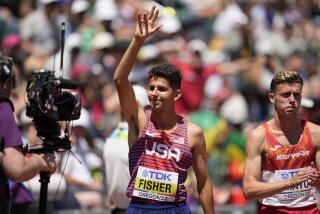After 4 Years of High Hopes, High Jumps and Hard Training for the Decathlon . . . : Odgers Continues His Odyssey Toward Spot on Olympic Team
- Share via
At about 9 a.m. Wednesday morning, Steve Odgers will crouch down in the starting blocks on the brick-red-colored track at the U.S. Olympic track and field trials at Indianapolis.
The race will be a short one, just 100 meters in length. And it’s a race that Odgers, a 26-year-old Irvine resident, has run before in a scant 11.03 seconds.
But the 100-meter event will be only a small part of a larger journey--one that includes nine other events and will take two days to complete. Odgers will also be tested in the 400 meters, the 1,500 meters, the 110-meter high hurdles, the shotput, discus, javelin, long jump, high jump, and pole vault.
Odgers is trying for one of three spots on the U.S. decathlon team that will compete in the Olympics in Seoul.
And yet, while Odgers will have a long way to go Wednesday and Thursday, it will seem a short distance compared to the four-year trek he has taken to get to Indianapolis.
Odgers has improved by leaps and bounds, not to mention sprints and throws, since first taking up the decathlon as a freshman at Orange Coast College in 1980.
While at Edison High School, he showed no hints of becoming a national-class competitor in any track event. He was a high jumper and long jumper whose best marks were 6-feet in the high jump and 21-feet in the long jump. Those marks might not even place among the top three in a good high-school dual meet.
He had never raced a step while at Edison, where he graduated in 1979. This is hardly good background for the decathlon and its four running events.
And when he first tried the decathlon as a freshman at Orange Coast, he scored only 5,600 points. His best is 7,991 set at the Mount San Antonio College Invitational in 1986.
Decathlon points are scored by comparing an individual’s performance in each event with a theoretical norm.
A 10.00 in the 100 meters, for example, is worth a lot more points than an 11.0 timing. Thus it’s possible, by scoring consistently high marks, to win a decathlon without winning all the individual events.
In his first decathlon in 1980, Odgers had a few problems with some of the events that were new to him. None caused him as much grief as the pole vault. He jumped 8-6 the first time he tried it.
That would get you laughed out of almost every high school meet. He has since improved to 14-9.
He also had problems with the shotput. The first time he tried it, the shot went only 34 feet.
How poor a throw is that?
Well, Jackie Joyner-Kersee threw the women’s shot (lighter by about two pounds) 51-4 Friday on her way to her world record in the heptathlon.
But Odgers persisted, stayed with it and gradually improved to throw for a personal best to 49-9.
He moved on to UC Irvine for his junior season, and by the time he was a senior in 1984, he was good enough to qualify for the National Collegiate Athletic Assn. meet, held that year at Eugene, Ore.
He finished back in the pack, but it gave him incentive to continue training with the hopes of competing in the trials this year.
He said he is hopeful of scoring 8,250 points, which he thinks will be enough to put him on the team for Seoul.
“I started thinking about it four years ago,” Odgers said. “I trained the last four years with the intention of being where I am right now.”
But the question is how did he get here? How did he improve sufficiently to qualify for the trials?
“I’ve put a lot of emphasis on well-rounded conditioning,” he said. “I do circuit training and weight training and maintain a high level of conditioning.
“It was more important to initially find a balance (among the 10 events). I found if I developed the speed it, in turn, helps the jumps.”
Odgers made the U.S. national team in 1985 and in 1986. He also competed in the ’86 Sports Festival.
It hasn’t hurt Odgers that a number of top international track athletes work out at UC Irvine, which is just up the hill from his home.
While working out at his alma mater, Odgers can stumble across Edwin Moses, the world’s best 400-meter hurdler, or Daley Thompson, the two-time gold medal winner in the decathlon from Great Britain. Recently, Dwight Stones, the nation’s top high jumper until just a few years ago, helped Odgers with his technique.
“Daley is a good friend,” Odgers said. “I stayed with him in London in 1986. He’s an inspiration. He trained here for three months this winter. He helps me a lot. There’s not many better people in the world to train with.”
Odgers trained up to three times a day last fall in preparation for this week’s meet. He did so in order to shore up his weaker events, such as the pole vault.
“This year, I only competed in about four or five meets,” Odgers said. “I used the meets for more intense things, competing in just two or three events.”
It’s paying off for Odgers, who now stands poised to complete his four-year odyssey.
“I just stuck to it,” Odgers said, trying to explain his recent success. “You’ve gotta have patience to stick with it.”
More to Read
Go beyond the scoreboard
Get the latest on L.A.'s teams in the daily Sports Report newsletter.
You may occasionally receive promotional content from the Los Angeles Times.






